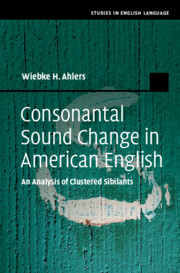3 results
Chapter 5 - Results
-
- Book:
- Consonantal Sound Change in American English
- Published online:
- 10 August 2023
- Print publication:
- 24 August 2023, pp 120-194
-
- Chapter
- Export citation
Chapter 6 - Discussion
-
- Book:
- Consonantal Sound Change in American English
- Published online:
- 10 August 2023
- Print publication:
- 24 August 2023, pp 195-207
-
- Chapter
- Export citation

Consonantal Sound Change in American English
- An Analysis of Clustered Sibilants
-
- Published online:
- 10 August 2023
- Print publication:
- 24 August 2023

